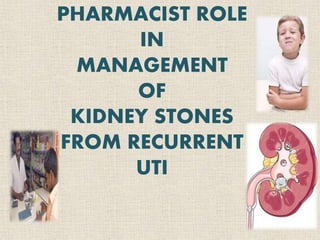An In-Depth Analysis of Treatment Options for Kidney Stones Versus Urinary Tract Infections: What You Need to Know
While UTIs are normally addressed with anti-biotics that offer quick alleviation, the method to kidney stones can vary significantly based on private variables such as stone dimension and make-up. Non-invasive methods like extracorporeal shock wave lithotripsy (ESWL) might be ideal for smaller stones, yet bigger or obstructive stones commonly require more invasive techniques.
Recognizing Kidney stones
Kidney stones are difficult down payments developed in the kidneys from minerals and salts, and recognizing their make-up and development is important for efficient administration. The main kinds of kidney stones include calcium oxalate, calcium phosphate, struvite, uric acid, and cystine stones, each with unique biochemical origins.
The development of kidney stones occurs when the concentration of particular materials in the pee enhances, bring about formation. This formation can be affected by urinary system pH, quantity, and the presence of preventions or promoters of stone development. Reduced pee volume and high level of acidity are favorable to uric acid stone advancement.
Understanding these aspects is important for both prevention and treatment (Kidney Stones vs UTI). Effective administration techniques may consist of nutritional adjustments, boosted liquid consumption, and, sometimes, pharmacological interventions. By identifying the underlying reasons and sorts of kidney stones, healthcare providers can carry out customized techniques to alleviate recurrence and enhance patient outcomes
Summary of Urinary Tract Infections
Urinary system tract infections (UTIs) prevail microbial infections that can impact any part of the urinary system, including the kidneys, ureters, bladder, and urethra. Most of UTIs are triggered by Escherichia coli (E. coli), a type of bacteria generally discovered in the intestinal tracts. Ladies are extra at risk to UTIs than guys because of physiological differences, with a shorter urethra promoting less complicated microbial accessibility to the bladder.
Symptoms of UTIs can differ relying on the infection's location but often include constant urination, a burning feeling throughout urination, cloudy or strong-smelling pee, and pelvic pain. In a lot more extreme instances, especially when the kidneys are entailed, signs and symptoms might additionally include high temperature, chills, and flank pain.
Threat factors for establishing UTIs include sex-related task, certain types of birth control, urinary system problems, and a damaged immune system. Prompt therapy is vital to avoid issues, consisting of kidney damages, and usually involves prescription antibiotics customized to the particular bacteria involved.
Treatment Alternatives for Kidney stones

If the stones are larger or create significant discomfort, non-invasive procedures such as extracorporeal shock wave lithotripsy (ESWL) might be employed. This strategy makes use of sound waves to damage the stones right into smaller sized pieces that can be extra easily travelled through the urinary system tract.
In situations where stones are also huge for ESWL or if they obstruct the urinary system, ureteroscopy might be suggested. This minimally invasive treatment includes making use of a small extent to damage or get click over here now rid of up the stones straight.

Therapy Choices for UTIs
Just how can health care suppliers properly address urinary system system infections (UTIs)? The key technique involves a complete assessment of the client's symptoms and clinical background, adhered to by ideal analysis screening, such as urinalysis and pee culture. These tests aid determine the original virus and determine their antibiotic vulnerability, guiding targeted therapy.
First-line treatment generally consists of antibiotics, with alternatives such as nitrofurantoin or trimethoprim-sulfamethoxazole, depending upon local resistance patterns. For uncomplicated cases, a short program of antibiotics (3-7 days) is typically sufficient. In recurring UTIs, service providers may take into consideration different strategies or prophylactic antibiotics, including lifestyle adjustments to minimize danger variables.
For people with challenging UTIs or those with underlying health problems, much more aggressive treatment might be essential, possibly involving intravenous prescription antibiotics and additional analysis imaging to analyze for problems. Furthermore, individual education and learning on over here hydration, health methods, and sign management plays a crucial role in prevention and recurrence.
Comparing End Results and Efficiency
Evaluating the results and effectiveness of therapy choices for urinary tract infections (UTIs) is necessary for maximizing person treatment. The key treatment for uncomplicated UTIs generally involves antibiotic treatment, with alternatives such as fosfomycin, nitrofurantoin, and trimethoprim-sulfamethoxazole.
In contrast, treatment end results for kidney stones differ significantly based upon stone place, structure, and dimension. Alternatives vary from conventional management, such as hydration and discomfort control, to interventional procedures like extracorporeal shock wave lithotripsy (ESWL) and ureteroscopy. While ESWL has a high success rate for smaller sized stones, complications can develop, necessitating additional interventions.
Eventually, the effectiveness of treatments for both problems rests on exact diagnosis and customized techniques. While UTIs usually react well to prescription antibiotics, kidney stone monitoring might need a complex method. Constant analysis of treatment outcomes is essential to boost client experiences and reduce reappearance rates for both UTIs and kidney stones.
Final Thought
In recap, therapy approaches for kidney stones and urinary system tract infections vary considerably due to the unique nature of each condition. Non-invasive approaches such as extracorporeal shock wave lithotripsy are appropriate for smaller stones, whereas larger or obstructive stones may call for ureteroscopy.
While UTIs are normally attended to with anti-biotics that provide fast alleviation, the strategy to kidney stones can vary dramatically based on individual variables such as stone size and structure. Non-invasive methods like extracorporeal shock wave lithotripsy (ESWL) might be appropriate for smaller stones, yet larger or obstructive stones frequently call for even more intrusive methods. The primary kinds of kidney stones include calcium oxalate, calcium phosphate, struvite, uric acid, and cystine official statement stones, each with unique biochemical beginnings.In contrast, treatment results for kidney stones differ substantially based on stone area, dimension, and structure. Non-invasive approaches such as extracorporeal shock wave lithotripsy are ideal for smaller stones, whereas bigger or obstructive stones might need ureteroscopy.